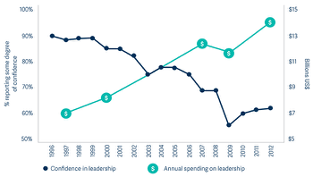 If you Google the word “leadership”, you’ll get nearly three billion hits. And below that, there will be ads for leadership courses – enter “leadership course NZ” and wade through over nine million hits. Type in “leadership awards NZ” and gaze in wonder at the breadth and variety of annual dinners and ceremonies feting leadership.
If you Google the word “leadership”, you’ll get nearly three billion hits. And below that, there will be ads for leadership courses – enter “leadership course NZ” and wade through over nine million hits. Type in “leadership awards NZ” and gaze in wonder at the breadth and variety of annual dinners and ceremonies feting leadership.
Personally, I think the whole leader thing is becoming somewhat overblown. In large organisations – and the Public Service in particular – it has grown to become an end in itself, something to be grasped and possessed by ambitious individuals. To my eye leadership is becoming unmoored from results, and that is a very bad thing.
Humans have evolved to respond to leadership: as a species we have always lived and worked in groups and every group has a status hierarchy. The closer to the top of the hierarchy the greater the rewards, be that money, decision rights, invitations to dinner with the rich and famous and so on.
For the rest of us there exists an explicit tradeoff: you people at the top of the pile may enjoy better perks than us if you make sound decisions, that are in the interests of the rest of us, and that deliver us all a better life. The critical point is that leadership should be a resource for the good of the group.
But consider this: as spending on leadership development has grown to nearly $400 billion per annum trust in leadership has fallen. Leadership development has lost ground to leader development, to the detriment of followers, organisations and institutions (US spend to 2012 shown below).

It’s instructive to study what followers want from leaders. By examining over 1 million data points from around 40,000 New Zealand workers, we explored what differentiated the most and least highly regarded leaders – and then looked at the impact they had on their followers.
We wanted to understand what good leaders do (not just what they say they do).
The most revealing finding was that the best leaders invest 30% more time in managing and developing their staff. That is, they are on the floor with their people talking about their individual performance, providing feedback and coaching, and being present and interested.
Secondly, they dealt promptly with poor performance in the team. That didn’t mean hard-hearted firing. Rather it was a sign they expected high standards and held people to account for delivering. People prefer being on a winning team, and carrying a colleague who can’t or won’t perform is terribly demotivating.
Thirdly, the best leaders built a connection between daily tasks (whatever it was - doing an audit, packing chickens, building a house) and a deeper purpose. Not misty-eyed corporate mumbo jumbo, built a personal connection. For example, when I worked at the Te Rapa dairy factory filling milk powder bags our foreman ensured we all shook hands and committed to work well and safely for each other at the start of every single shift. Boring work, but a great atmosphere.
Finally, the best leaders managed themselves well. They tended to be optimistic, resilient and, above all, they stayed calm and even-tempered.
There is a clear bottom-line benefit from getting leaders to do leadership well. In our study of over 6000 managers, 90% of the staff of the poorest leaders were disengaged, which translates as non-productive, disaffected and looking for work anywhere else. That rate dropped to below 10% for the best rated leaders, and their engaged staff hovered around the 80% mark.
I think the very best leaders grasp the difference between a verb and a noun. To lead means to do things that help the team be successful, and bring benefits to all of us here in Aotearoa.
To lead is an action, not a position.
Photo credit: Ian Schneider, Unsplash
